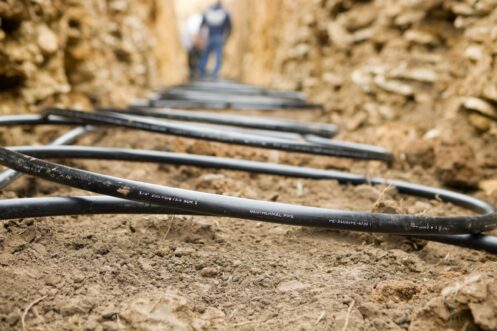Digging Deep: Geothermal Comfort for Missouri’s Weather Swings

Missouri weather doesn’t stay in one lane. You face sticky heat in the summer, deep freezes in the winter, and constant swings during the shoulder seasons. That kind of back-and-forth puts standard HVAC systems to the test. Geothermal systems handle it differently by working with the ground, not against the air.
At Hoff Heating & AC, in O’Fallon, MO, we’ve helped homeowners make the switch to geothermal systems that match Missouri’s unpredictable weather patterns. If you’ve been curious about digging a little deeper into how your home stays comfortable, this blog is a solid place to start.
Underground Stability Helps Your Energy Bills
The ground deep below your lawn stays around 55°F year-round. When a geothermal system pulls heat from the ground, it doesn’t face extremes like an outdoor unit would. In Missouri, where winter mornings dip well below freezing and summer afternoons boil above 90°F, that stability matters.
You replace battling the hot or cold air with leveraging a mild underground temperature. As a result, the system uses less power to move heat around. You’ll notice that your power meter ticks more slowly and your bills shrink noticeably compared to traditional systems. Many homeowners report months when their HVAC energy use drops significantly. That makes a real difference during long Midwest summers and brutal winter cold snaps.
Even though the upfront cost for geothermal loops and installation is higher, your energy use pays it off bit by bit. Imagine your electric bill during peak summer needing less air conditioner workload. In winter, the heat pump moves warmth from the ground inside, instead of generating heat. You avoid electric resistance heating or burning gas. Over each year, those savings add up. The system works quietly and steadily, without big spikes. It’s easier to plan for utilities instead of bracing for a seasonal bill shock.
A Hitch in the Ground Loop
Geothermal systems live underground in loop pipes buried below the frost line. Proper digging and design matter here. Missouri soil varies. Some areas hold water well; others don’t. When installers lay pipes, they need to test the soil and place loops in spots where the ground can absorb or reject heat reliably. If a loop crosses wet and dry patches unevenly, the system may struggle. It might not heat or cool well if one part of the loop heats slowly.
Homes on small lots or with rocky soil need special walk-out designs or vertical loops. Vertical loops drill deeper but reach stable ground. That method works in limited spaces. However, drilling costs rise with rock or hard layers. On the other hand, horizontal loops take up more yard space and may interfere with landscaping or underground pipes. You’ll want installers who assess soil, the drilling cost, and yard layout before ruining your outdoor plan. A thoughtful design up front saves performance issues later.
Proper ground loop placement also avoids trees, drainage lines, septic systems, or property lines. Those pieces interact with heat flow. If a loop runs too close to a big tree root, the root might grow around the pipe and squeeze it. That slows heat exchange. If it crosses a drain field, the loop could shift when the soil moves. So, take loop planning seriously. It matters for long-term performance and protects your yard from hidden damage.
Year-Round Comfort With Few Moving Parts
Unlike a gas furnace or traditional heat pump, geothermal gear lives inside a utility room. Outside, you won’t see a loud condenser fan or coils that get noisy during a cold or hot snap. Inside, the system uses underground loops and a water pump to move heat. That means fewer outdoor components that need service or face freezing damage in cold weather. When a summer storm rolls through or ice coats your roof in winter, your system keeps working without worrying about exposed parts.
A heat exchange unit and water pump carry warmth in or out, and the machine runs steadily. That steady operation helps humidity stay balanced, too. Forget blasting cold air that dries you out in June or rapid heat that dries wood floors in January. The system matches your thermostat setting and holds it without big swings.
Missouri Weather and Environmental Impact
Missouri weather swings a lot. Spring storms bring heavy rain. Summer humidity sticks around. Fall drops are dramatic. Winter freezes can linger.
Since geothermal doesn’t burn fossil fuels, you avoid carbon monoxide emissions in your home. That matters for families who care about air quality or climate impact. It also removes concerns about gas leaks or combustion fumes. Wells and pipes inside the house move warm or cool water, not fuel. The outside air no longer needs to match your comfort goal. Even if it dips to zero in January, your house stays comfortable thanks to the stable ground temperature.
Missouri has mixed utility pricing depending on electric rate plans. Some plans reward steady, low-power consumption. A geothermal system stays in a lower consumption band. You avoid high-cost peak demand charges that come with systems that cycle hard. By flattening your energy use, you pay less over time. You also reduce stress on your local electric grid, which benefits everyone. For homeowners who value efficiency and climate friendliness, that impact is part of the appeal.
Local Codes, Regulations, and Insurance Considerations
Installing a geothermal system involves more than digging holes and laying pipes. You also need to think about permits, zoning rules, and how the system might affect your homeowner’s insurance. Missouri doesn’t have a single statewide geothermal policy, so requirements vary depending on where your home is located.
Some counties require geological surveys before you drill, especially if your property lies near groundwater reserves or protected soil zones. In urban or suburban areas, there may also be rules around how close the loop can be to property lines, sewer connections, or underground electrical cables. If you live in a historic district or neighborhood with an HOA, additional approval might be needed before excavation begins.
Permitting often involves submitting loop layout designs and equipment specs, especially if the project includes vertical drilling. Some municipalities require an inspection both before and after installation, and they might ask for documentation that confirms the installer is certified for geothermal work.
If you’re using state or federal rebates, those programs often come with additional paperwork. Miss a step, and you could delay the rebate or lose it altogether. That’s one more reason why working with a team that knows the local permitting process matters as much as the system itself.
Insurance companies vary in how they treat geothermal. In some cases, your policy won’t change at all. But other times, especially if drilling is involved, they may ask for proof that the work was professionally installed and certified. They might require that the loop system be added to your coverage.
This helps protect you in case something like a pipe shift causes damage to your yard or foundation. It’s smart to call your provider before the work begins so you don’t face issues down the road. A geothermal system can add long-term value to your home, but only if it’s properly documented and protected.
Let’s Talk About Adding Geothermal to Your Home Today
In a state like Missouri where summers get muggy and winters bite back, having something steady below ground can make life easier above it. Hoff Heating & AC has served Missouri homeowners with heating and cooling services since 1983, offering expert installation, repair, and maintenance backed by NATE‑certified technicians. If you’re ready to explore whether a geothermal system makes sense for your home, Hoff Heating & AC is here to help you start that conversation.

 Call Us Today
Call Us Today
